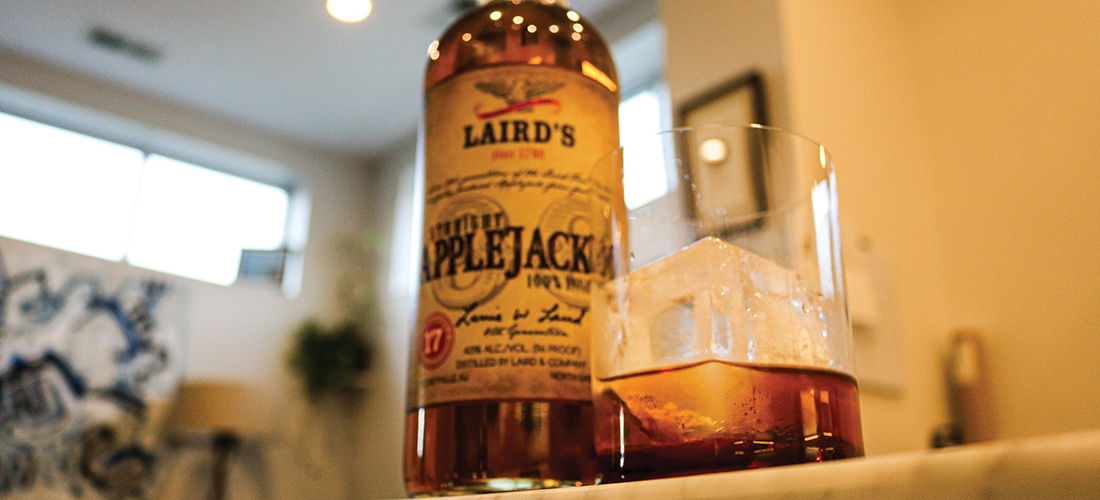
Apples to Autumn
Leaf-fallin’ brandy cocktails
By Tony Cross
Over the summer, I read about a 50/50 cocktail that intrigued me. The drink is simply an “equal parts” cocktail, and this one had applejack in it. Admittedly, it has been at least a full minute since I’ve had anything with applejack or Calvados in it, so I thought it was the perfect time to dust that bottle off and give it a go. The drink was so good, I ordered more of the brandy online.
Brandy is Dutch for “burned wine.” It’s a spirit distilled from wine or fermented juice from apples, pears, plums and so on. In the case of apple brandy, cider apples usually supply the juice. Jim Meehan’s Bartender Manual says: “Today, brandy is produced all over the world, but the world’s most prized bottlings — barrel-aged Cognacs and Armagnacs from wine, Calvados from cider, and clear eau de vie and schnapps from ripe berries and tree fruit — are all produced in the European Union.”
Before we get into the cocktails, let’s do a quick breakdown of the categories of apple brandy. My trusty Death & Co. cocktail book has this to say:
Calvados: This French apple brandy, produced in the Calvados region, is defined by production and aging regulations similar to those for Cognac and Armagnac. It tends to have crisp apple flavor with loads of barnyard funk.
Straight apple brandy: This term refers to American apple brandy. Laird’s bonded apple brandy adheres to the same set of standards required for bonded whiskey, yielding a rich, deeply aged, spicy spirit.
Applejack: Though traditionally produced by freezing distillation (a process known as jacking), modern applejack is typically a combination of apple brandy and a neutral grain spirit (30 and 70 percent, respectively).
With Calvados, you have categories defined by minimum years in oak casks:
• Fine, Trois Etoiles (three stars), VS: 2 years
• Reserve/Vieux: 3 years
• Vieille Reserve, VO, VOSP: 4 years
• XO, Tres Vieux, Extra, Hors d’Age: 6 years
The first time I had apple brandy was from Laird’s, which uses pressed Golden Delicious and Red, Fuji, Gala, Jonathan, Stayman and Winesap apples. I’ve only eaten (to my knowledge) four of those seven varieties. What I love about their bottled-in-bond straight apple brandy is the higher proof. It gives cocktails a little more oomph from the spiciness courtesy of the ABV. The classic Jack Rose cocktail was my first love affair with apple brandy, and it goes a little something like this:
Jack Rose
2 ounces Laird’s Bottled-in-Bond Straight Apple Brandy
3/4 ounce lemon juice
3/4 ounce grenadine
Shake all ingredients with ice and strain into a chilled cocktail coupe. No garnish.
(Grenadine: Combine equal parts raw or demerara sugar with POM Wonderful pomegranate juice. Stir over medium heat until sugar is dissolved. You may add a touch of pomegranate molasses for depth.)
The following drink is courtesy of Meehan, who added it to his menu when Brooklyn cocktails (rye whiskey, dry vermouth, Luxardo and Amer Picon — a bitter orange liqueur from France) were all the rage. “We looked across the river for inspiration, and came up with this New Jersey apple brandy-based twist, which substituted Fernet-Branca for Amer Picon. Boozy and bitter, it was, we felt, worthy enough to be Newark’s namesake.”
Newark
2 ounces Laird’s apple brandy
1 ounce Vya sweet vermouth (or Cocchi Vermouth di Torino)
1/4 ounce Fernet-Branca
1/4 ounce Luxardo maraschino liqueur
Stir all ingredients with ice, then strain into a chilled cocktail coupe. No garnish.
Coming full circle, let’s talk about that 50/50 cocktail I embraced over the summer. I read about it in Punch magazine. While Seattle bar consultant Lindsay Matteson says the 50/50, “should always be a shot, room temperature and two ounces,” I pour mine over a rock at the casa. The CIA (Cynar in applejack) is a delicious pairing. A dash of Angostura bitters brings the drink all together for this simple sipper. It’s the creation of New York City bar owner Sother Teague, who keeps a batched bottle (at room temperature) on hand, making it simpler yet. Cynar is a low ABV, artichoke-based Italian liqueur; slightly sweet, slightly bitter. Every now and then I’ll add a quarter- to a half-ounce of rye whiskey to give this a little more fuel. Keep in mind, with any of these cocktails you can swap out Laird’s for Calvados to give your cocktail a slightly different profile.
CIA
1 ounce Cynar
1 ounce Laird’s apple brandy
1 dash Angostura bitters
Two ways to mix: Pour into a shot glass at room temperature and imbibe or build the drink in a rocks glass with one large cube and stir briefly. No garnish is needed, but every now and then, I’ll add an orange or lemon peel. PS
Tony Cross is a bartender (well, ex-bartender) who runs cocktail catering company Reverie Cocktails in Southern Pines.





